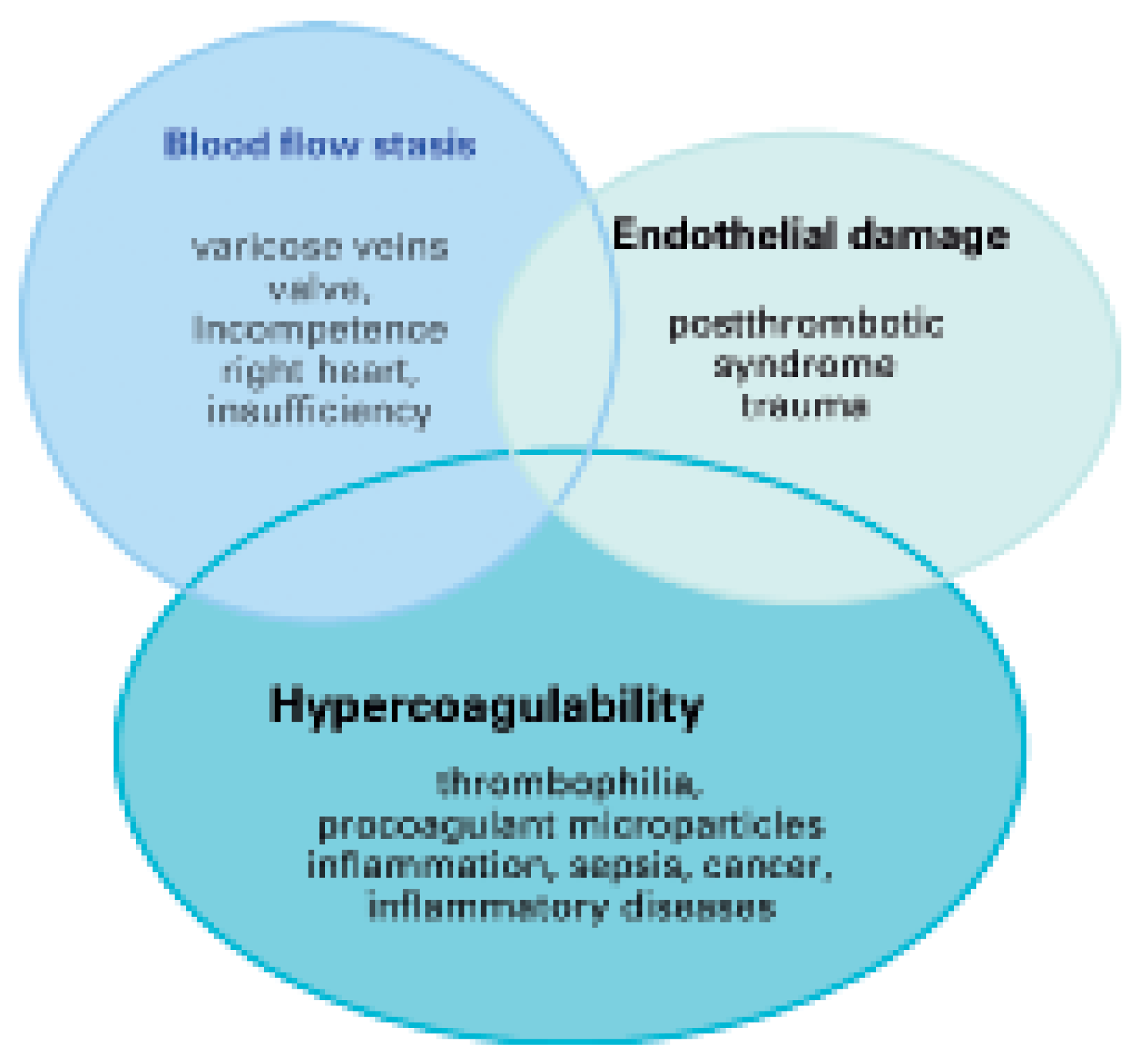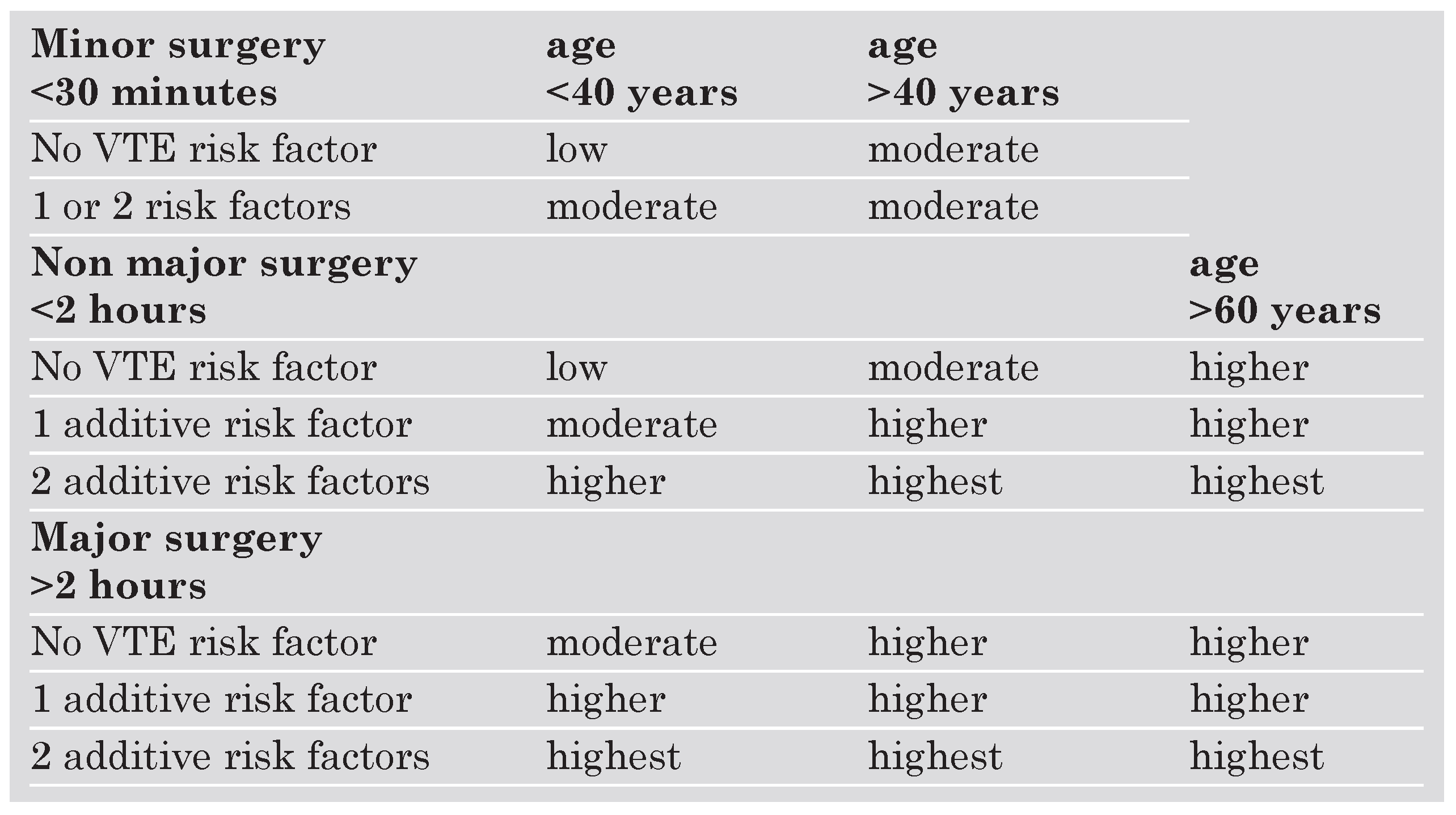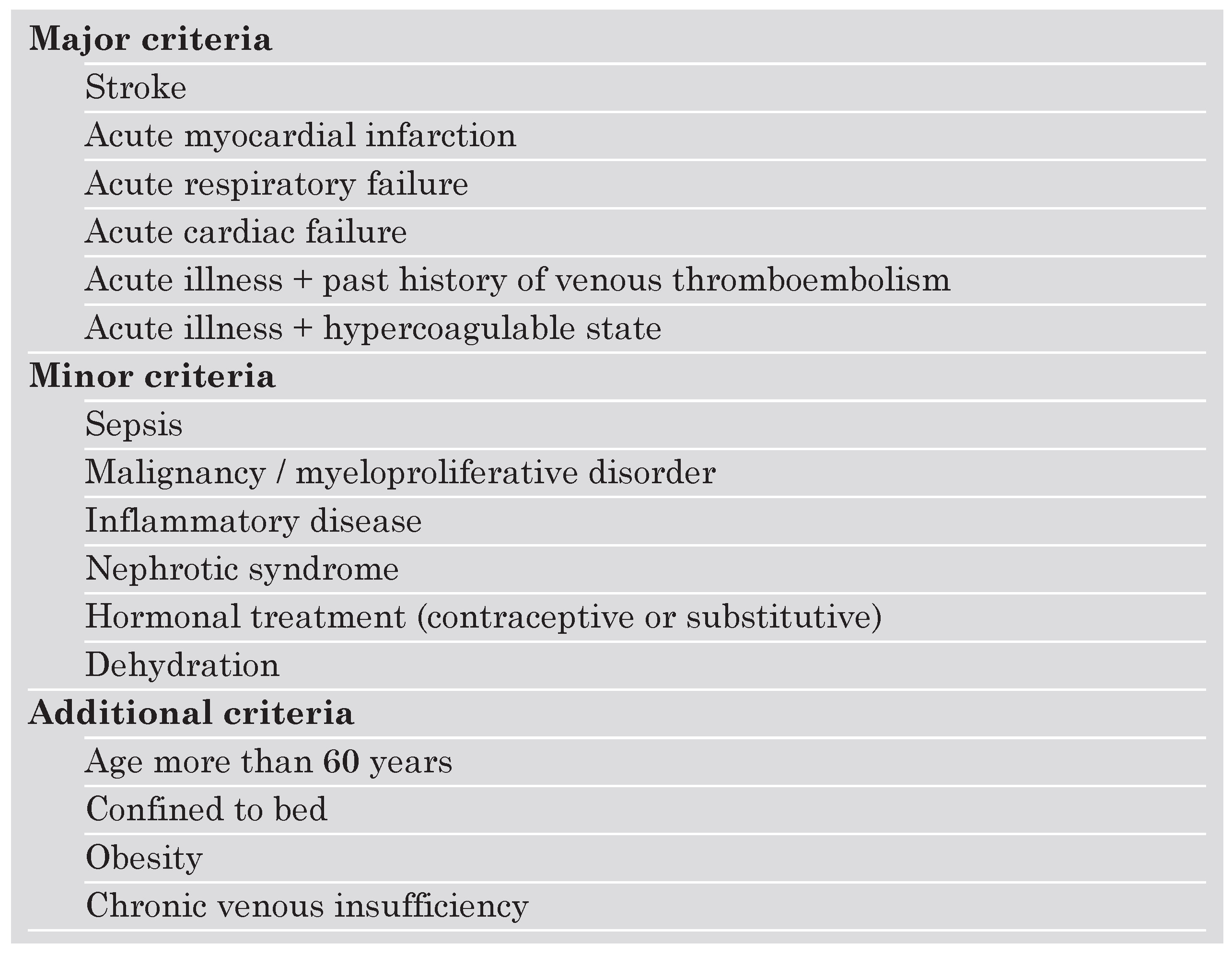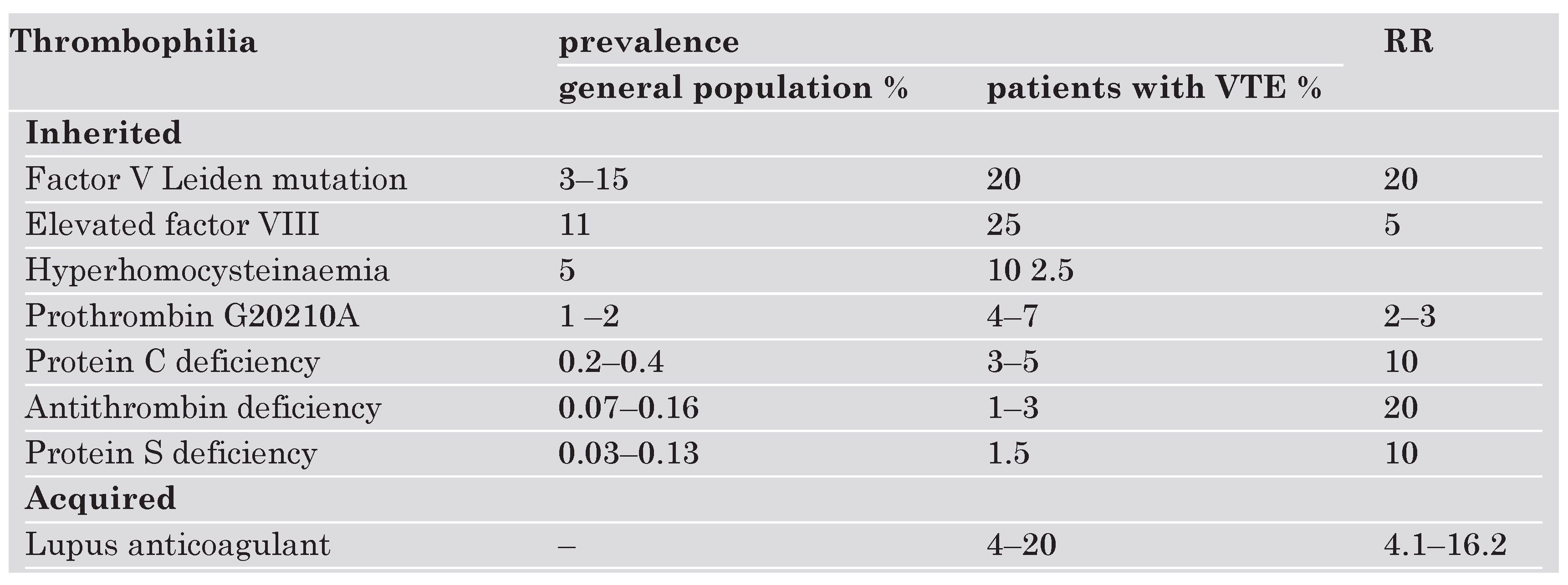Clinical Significance of Risk Factor Assessment for the Prevention of Venous Thromboembolism
Abstract
Zusammenfassung
Introduction
Pathophysiological influence of risk factors on the occurrence of VTE
Risk factor assessment for thromboprophylactic treatment of hospitalised patients
Thrombophilia and concomitant risk factors
References
- Wells, P.S.; Hirsh, J.; Anderson, D.R.; Lensing, A.W.; Foster, G.; Kearon, C.; et al. Accuracy of clinical assessment of deep-vein thrombosis. Lancet 1995, 345, 1326–1330. [Google Scholar] [CrossRef]
- Geerts, W.H.; Pineo, G.F.; Heit, J.A.; Bergqvist, D.; Lassen, M.R.; Colwell, C.W.; et al. Prevention of venous thromboembolism: The Seventh ACCP Conference on Antithrombotic and Thrombolytic Therapy. Chest 2004, 126, 338S–400S. [Google Scholar] [CrossRef]
- Virchow, R.L.K. (translated by: Matzdorff, et al). Thrombose und Embolie. Science History Publications: Canton, MA, 1998.
- Kearon, C. Epidemiology of venous thromboembolism. Semin Vasc Med 2001, 1, 7–25. [Google Scholar] [CrossRef] [PubMed]
- Sevitt, S. The structure and growth of valve-pocket thrombi in femoral veins. J Clin Pathol 1974, 27, 517–528. [Google Scholar] [CrossRef]
- Baglin, T.; Luddington, R.; Brown, K.; Baglin, C. Incidence of recurrent venous thromboembolism in relation to clinical and thrombophilic risk factors: Prospective cohort study. Lancet 2003, 362, 523–526. [Google Scholar] [CrossRef] [PubMed]
- Caprini, J.A.; Goldshteyn, S.; Glase, C.J.; Hathaway, K. Thrombophilia testing in patients with venous thrombosis. Eur J Vasc Endovasc Surg 2005, 30, 550–555. [Google Scholar] [CrossRef] [PubMed][Green Version]
- Mansilha, A.; Araujo, F.; Severo, M.; Sampaio, S.M.; Toledo, T.; Albuquerque, R. Genetic polymorphisms and risk of recurrent deep venous thrombosis in young people: Prospective cohort study. Eur J Vasc Endovasc Surg 2005, 30, 545–549. [Google Scholar] [CrossRef]
- Emmerich, J.; Vossen, C.Y.; Callas, P.W.; Demers, C.; Naud, S.; Long, G.L.; et al. Chronic venous abnormalities in symptomatic and asymptomatic protein C deficiency. J Thromb Haemost. 2005, 3, 1428–1431. [Google Scholar] [CrossRef][Green Version]
- Dahm, A.; Van Hylckama Vlieg, A.; Bendz, B.; Rosendaal, F.; Bertina, R.M.; Sandset, P.M. Low levels of tissue factor pathway inhibitor (TFPI) increase the risk of venous thrombosis. Blood 2003, 101, 4387–4392. [Google Scholar] [CrossRef]
- Lisman, T.; de Groot, P.G.; Meijers, J.C.; Rosendaal, F.R. Reduced plasma fibrinolytic potential is a risk factor for venous thrombosis. Blood 2005, 105, 1102–1105. [Google Scholar] [CrossRef]
- Chirinos, J.A.; Heresi, G.A.; Velasquez, H.; Jy, W.; Jimenez, J.J.; Ahn, E.; et al. Elevation of endothelial microparticles, platelets, and leukocyte activation in patients with venous thromboembolism. J Am Coll Cardiol. 2005, 45, 1467–1471. [Google Scholar] [CrossRef] [PubMed]
- Myers, D.D.; Hawley, A.E.; Farris, D.M.; Wrobleski, S.K.; Thanaporn, P.; Schaub, R.G.; et al. P-selectin and leukocyte microparticles are associated with venous thrombogenesis. J Vasc Surg 2003, 38, 1075–1089. [Google Scholar] [CrossRef]
- Giesen, P.L.; Rauch, U.; Bohrmann, B.; et al. Blood-borne tissue factor: Another view of thrombosis. Proc. Natl. Acad. Sci. USA 1999, 96, 2311–2315. [Google Scholar] [CrossRef] [PubMed]
- Mackman, N. Arterioscler Thromb Vasc Biol 2004, 24, 1015–1022. [CrossRef]
- Combes, V.; Simon, A.C.; Grau, G.E.; Arnoux, D.; Camoin, L.; Sabatier, F.; et al. In vitro generation of endothelial microparticles and possible prothrombotic activity in patients with lupus anticoagulant. J Clin Invest 1999, 104, 93–102. [Google Scholar] [CrossRef] [PubMed]
- Bogdanov, V.Y.; Balasubramanian, V.; Hathcock, J.; et al. Alternatively spliced human tissue factor: A circulating, soluble, thrombogenic protein. Nat Med 2003, 9, 458–462. [Google Scholar] [CrossRef]
- Nieuwland, R.; Berckmans, R.J.; McGregor, S.; Boing, A.N.; Romijn, F.P.; Westendorp, R.G.; et al. Cellular origin and procoagulant properties of microparticles in meningococcal sepsis. Blood 2000, 95, 930–935. [Google Scholar] [CrossRef]
- Rao, L.V.M. Tissue factor as a tumor procoagulant. Cancer Metastasis Rev 1992, 11, 249–266. [Google Scholar]
- Diamant, M.; Nieuwland, R.; Pablo, R.F.; Sturk, A.; Smit, J.W.; Radder, J.K. Elevated numbers of tissue-factor exposing microparticles correlate with components of the metabolic syndrome in uncomplicated type 2 diabetes mellitus. Circulation 2002, 106, 2442–2447. [Google Scholar] [CrossRef]
- Mallat, Z.; Benamer, H.; Hugel, B.; Benessiano, J.; Steg, P.G.; Freyssinet, J.M. , et al A. Elevated levels of shed membrane microparticles with procoagulant potential in the peripheral circulating blood of patients with acute coronary syndromes. Circulation 2000, 101, 841–843. [Google Scholar] [CrossRef]
- Rosendaal, F.R. Risk factors for venous thrombosis: Prevalence, risk, and interaction. Semin Hematol 1997, 34, 171–187. [Google Scholar] [CrossRef]
- Samama, M.M.; Cohen, A.T.; Darmon, J.Y.; Desjardins, L.; Eldor, A.; Janbon, C.; et al. A comparison of enoxaparin with placebo for the prevention of venous thromboembolism in acutely ill medical patients. Prophylaxis in Medical Patients with Enoxaparin Study Group. N Engl J Med 1999, 341, 793–800. [Google Scholar] [CrossRef]
- Cohen, A.T.; Gallus, A.S.; Lassen, M.R.; et al. Fondaparinux vs placebo for the prevention of venous thromboembolism in acutely ill medical patients (ARTEMIS). J Thromb Haemost 2003. (suppl 1):abstract 2046. [Google Scholar]
- Leizorovicz, A.; Cohen, A.T.; Turpie, A.G.; Olsson, C.G.; Vaitkus, P.T.; Goldhaber, S.Z. PREVENT Medical Thromboprophylaxis Study Group. Randomized, placebo-controlled trial of dalteparin for the prevention of venous thromboembolism in acutely ill medical patients. Circulation 2004, 110, 874–879. [Google Scholar] [CrossRef]
- Chopard, P.; Doerffler-Melly, J.; Hess, U.; Wuillemin, W.A.; Hayoz, D.; Gallino, A.; et al. Venous thromboembolism prophylaxis in acutely ill medical patients: Definite need for improvement. J Intern Med 2005, 257, 352–357. [Google Scholar] [CrossRef] [PubMed]
- Kucher, N.; Koo, S.; Quiroz, R.; Cooper, J.M.; Paterno, M.D.; Soukonnikov, B.; et al. Electronic alerts to prevent venous thromboembolism among hospitalized patients. N Engl J Med 2005, 352, 969–977. [Google Scholar] [CrossRef] [PubMed]
- Nicolaides, A.N. Thrombophilia and venous thromboembolism. International Consensus Statement. Guidelines According to Scientific Evidence. Int Angiol. 2005, 24, 1–26. [Google Scholar] [CrossRef] [PubMed]
- Dahm, A.; van Hylckama Vlieg, A.; Bendz, B.; Rosendaal, F.; Bertina, R.M.; Sandset, P.M. Low levels of tissue factor pathway inhibitor (TFPI) increase the risk of venous thrombosis. Blood 2003, 101, 4387–4392. [Google Scholar] [CrossRef]
- Mansilha, A.; Arau’jo, F.; Severo, M.; Sampaio, S.; Toledo, T.; Henriques, I.; et al. The association between the 4G/5G polymorphism in the promoter of the plasminogen activator inhibitor-1 gene and deep venous thrombosis in young people. Phlebology 2005, 20, 48–52. [Google Scholar] [CrossRef]
- Eichinger, S.; Schonauer, V.; Weltermann, A.; Minar, E.; Bialonczyk, C.; Hirschl, M.; et al. Thrombin-activatable fibrinolysis inhibitor and the risk for recurrent venous thromboembolism. Blood. 2004, 103, 3773–3776. [Google Scholar] [CrossRef]
- Hoppe, B.; Tolou, F.; Radtke, H.; Kiesewetter, H.; Dorner, T.; Salama, A. Marburg I polymorphism of factor VII-activating protease is associated with idiopathic venous thromboembolism. Blood 2005, 105, 1549–1551. [Google Scholar] [CrossRef]
- De Groot, P.G.; Lutters, B.; Derksen, R.H.; Lisman, T.; Meijers, J.C.; Rosendaal, F.R. Lupus anticoagulants and the risk of a first episode of deep venous thrombosis. J Thromb Haemost 2005, 3, 1993–1997. [Google Scholar] [CrossRef] [PubMed]
- Christiansen, S.C.; Cannegieter, S.C.; Koster, T.; Vandenbroucke, J.P.; Rosendaal, F.R. Thrombophilia, clinical factors and recurrent venous thrombotic events. JAMA 2005, 293, 2352–2361. [Google Scholar] [CrossRef] [PubMed]
- Wu, O.; Robertson, L.; Langhorne, P.; Twaddle, S.; Lowe, G.D.; Clark, P.; et al. Oral contraceptives, hormone replacement therapy, thrombophilia and risk of venous thromboembolism: TREATS Study. Thromb Haemost 2005, 94, 17–25. [Google Scholar] [CrossRef] [PubMed]
- Chee, Y.L.; Watson, H.G. Air travel and thrombosis. Br J Haematol 2005, 130, 671–680. [Google Scholar] [CrossRef]

 |
 |
 |
 |
© 2006 by the author. Attribution - Non-Commercial - NoDerivatives 4.0.
Share and Cite
Dörffler-Melly, J. Clinical Significance of Risk Factor Assessment for the Prevention of Venous Thromboembolism. Cardiovasc. Med. 2006, 9, 94. https://doi.org/10.4414/cvm.2006.01160
Dörffler-Melly J. Clinical Significance of Risk Factor Assessment for the Prevention of Venous Thromboembolism. Cardiovascular Medicine. 2006; 9(3):94. https://doi.org/10.4414/cvm.2006.01160
Chicago/Turabian StyleDörffler-Melly, Janine. 2006. "Clinical Significance of Risk Factor Assessment for the Prevention of Venous Thromboembolism" Cardiovascular Medicine 9, no. 3: 94. https://doi.org/10.4414/cvm.2006.01160
APA StyleDörffler-Melly, J. (2006). Clinical Significance of Risk Factor Assessment for the Prevention of Venous Thromboembolism. Cardiovascular Medicine, 9(3), 94. https://doi.org/10.4414/cvm.2006.01160




